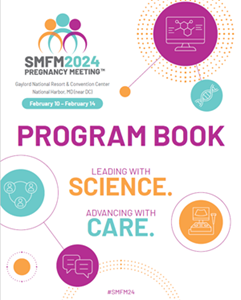Fetus
Poster Session 3
(894) Neighborhood deprivation is not associated with abortion consideration or completion in patients with fetal myelomeningocele

Steven T. Papastefan, MD (he/him/his)
Research Fellow
Northwestern University Feinberg School of Medicine
Chicago, IL, United States
Yuqi Bian, BA (she/her/hers)
Northwestern University Feinberg School of Medicine
Chicago, IL, United States- MS
Manmeet Singh, MS
The Chicago Institute for Fetal Health
Chicago, IL, United States - WM
William S. Marriott, MS
The Chicago Institute for Fetal Health
Chicago, IL, United States - JI
Joy Ito, RN
The Chicago Institute for Fetal Health
Chicago, IL, United States 
Jessica T. Fry, MD
Ann and Robert H. Lurie Children's Hospital of Chicago
Chicago, IL, United States- AS
Aimen Shaaban, MD
The Chicago Institute for Fetal Health
Chicago, IL, United States 
Ashish Premkumar, MD PhD (he/him/his)
Assistant Professor
University of Chicago
Chicago, Illinois, United States
Primary & Presenting Author(s)
Coauthor(s)
Social determinants of health are key drivers of maternal morbidity and adverse pregnancy outcomes, but the relationship to abortion decision-making for severe fetal anomalies is not known. We hypothesized that higher neighborhood deprivation index (NDI) is associated with abortion consideration and completion for pregnant patients with fetal myelomeningocele (fMMC).
Study Design: In this retrospective cohort study, patients with fMMC presenting to a tertiary fetal treatment center (FTC) in Illinois between 2018-2023 were identified. The exposure was NDI, calculated from patient zip codes. NDI was analyzed as both a dichotomous (i.e., above average to most v. average to least deprivation) and ordinal exposure. The co-primary outcomes were abortion consideration prior to FTC consultation, ascertained by nurse intake, and abortion completion after FTC consultation. Bivariate and log-binomial regression analyses were performed. Covariates were selected based on P< .10 on bivariate analyses. A subgroup analysis was performed on individuals residing only in Illinois. P< .05 indicated statistical significance.
Results: 124 patients were included. In evaluating NDI as a dichotomous exposure, NDI was not associated with abortion consideration or completion (Table 1). On log binomial modeling, after controlling for confounders of GA and ethnicity, NDI was also not significantly associated with abortion consideration (aRR 0.93, 95% CI 0.57-1.52) or completion (aRR 0.98, 95% CI 0.51-1.87). For a subgroup of individuals residing in Illinois (n = 83 [63.5%]), NDI was also not significantly associated with consideration (aRR 0.84, 95% 0.53-1.32) or completion (aRR 1.07, 95% CI 0.52-2.19). These results were similar when treating NDI as an ordinal exposure.
Conclusion: Contrary to our hypothesis, NDI is not associated with abortion consideration or completion in patients with fMMC. While NDI has traditionally been associated with adverse pregnancy outcomes, the lack of relationship with abortion for severe fetal anomalies underscores the importance of comprehensive counseling for all patients presenting to FTCs.

